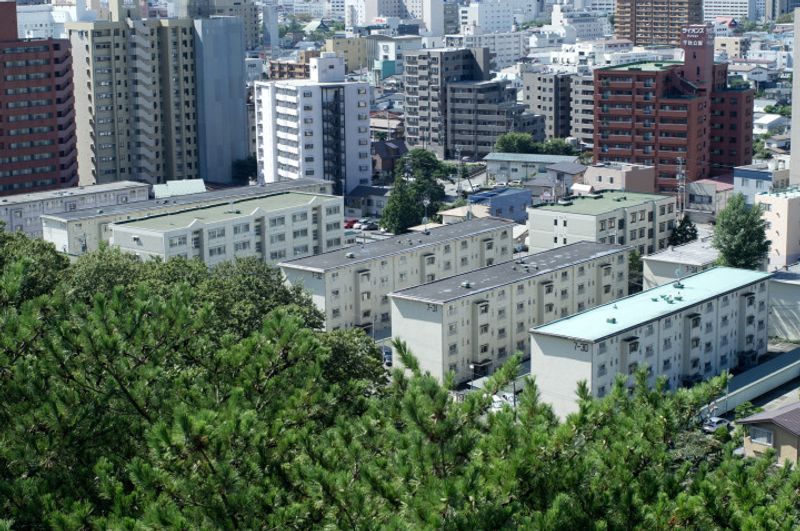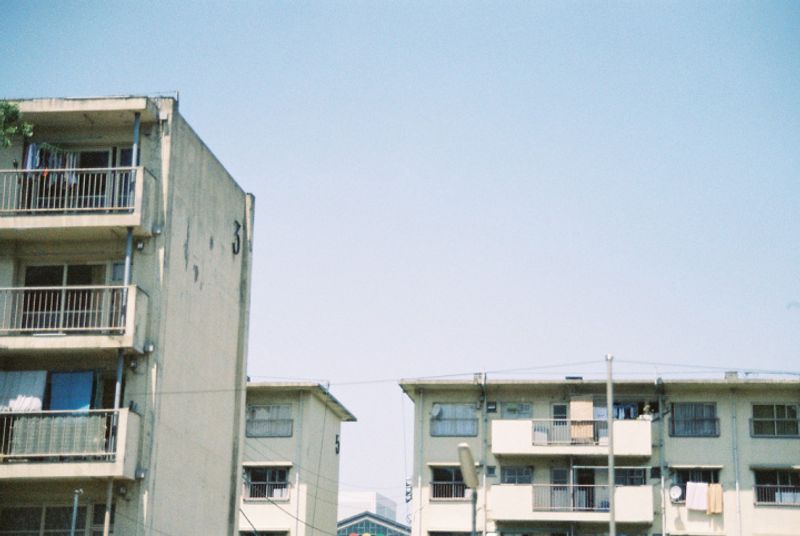Aug 3, 2017
Urban Renaissance housing in Japan: What, how, and how much

What is UR housing? Urban Renaissance housing in Japan stems from a sort-of public administration called the Urban Renaissance Agency, an operation that goes back to the mid 1950s set up to address shortages in housing in urban Japan during the post-war boom years. To put it simply, back home Urban Renaissance cribs might be known as council houses or council flats - more affordable accommodation for those who fall into lower income brackets. Urban Renaissance sounds way more snazzy then, or empty, depending on how full your glass of water is! Actually, the agency attempts to address more than just housing, having its fingers in a number of socially conscious pies and operating under the suitably Japanese-dreamy mission of “creating cities of beauty, safety, and comfort where people can shine.”
In a stark contrast to the “beauty” part of the statement above, Urban Renaissance housing, or rather, apartments often come in the form of danchi (団地) the Japanese term that points to those massive blocks of flats you can often see on the edges of large cities or in areas of suburbia in Japan. At their worst, Japan’s danchi spring to mind the cold lines and brutal efficiency of communism. At their best though, they can give off the light vibes of a cheap holiday apartment complex, especially if the greenery is well tended to, there’s an enthusiastic looking play area and, most importantly, the weather is bright and sunny.
Danchi aside, one might be surprised at some of the urban projects the Urban Renaissance Agency has been involved in including office redevelopment in Tokyo’s Otemachi and urban planning near Osaka Station. You can read more about these projects over at the Urban Renaissance Agency site.
Throwing in terms like “council housing”, “low income” together with the presence of government might lead the expat in Japan to think that Urban Renaissance housing isn’t available for them. This is not true, it is a legitimate accommodation option.
In fact, it’s one that deserves serious consideration due to the serious benefits that come with UR (the abbreviation) housing, namely:
No key money
No agent fee
No renewal of contract fee
No guarantor
Even in Japan’s ever easing accessibility of rental properties for foreign residents the above benefits will likely be music to the ears of many. The often bonkers expense demanded when moving into a new apartment in Japan can be frustrating to the point of tears, especially when often all you are getting is something only a slight step up from university digs. UR housing then, sounds promising. The UR agency also has complexes to accommodate those with pets, those who like to do a bit of DIY, and can also offer favorable rental agreements to those supporting young children.
With this open spirit though, comes some disadvantages, one being that, depending on the area, the prospective UR tenant needs to be on the ball as these places are filled on a first-come-first-served basis. Not that there need be any rush beyond that. Once you’ve settled on what they call the “permitted occupancy date” you have one month to get moved in.
The table below shows the administrative UR divisions of Japan with the highest number of UR managed apartments (and their number).
| Tokyo | 167,280 |
| Osaka Prefecture | 112,155 |
| Chiba Prefecture | 88,593 |
| Saitama Prefecture | 80,918 |
| Kanagawa Prefecture | 73,914 |
| Aichi Prefecture | 52,324 |
| Hyogo Prefecture | 51,907 |
| Fukuoka Prefecture | 45,867 |
| Kyoto Prefecture | 23,492 |
| Nara Prefecture | 14,996 |
* Data from the end of March 2016 - Source: Urban Renaissance Agency
How do I find and move into UR housing in Japan?
The Urban Renaissance Agency homepage has links to plenty of PDFs that detail a lot of the procedures, safety regulations, maintenance info, management structure and emergency support relating to UR housing … in English. However, we couldn’t find anything that detailed what you have to do to start looking for and eventually sign a tenant agreement for one of these things.
If you can handle the Japanese of course, the prospective tenant can begin UR searches online via the Urban Renaissance Agency homepage. Beyond this, it looks like you’ll need to go and visit a Residence Center or even the Administration Service Office of the complex itself. How well equipped the staff are to deal with inquiries in foreign languages, we don't know.
Still, such is the world we live in, even with an agency set up to make housing in Japan easier and essentially cut out some of the admin and lingering fees of apartment hunting in Japan, there are agencies that have sprung up acting as agencies of THE agency. Marvellous. Quite so in this case, as at least through these 3rd party agencies we can get some idea of what is needed to get the ball rolling.
Documents required to apply for UR housing:
- Residence Certificate - (juminhyo / 住民票) - from your ward / city office
- Tax Certificate - (kazei Shomeisho / 課税証明書) - from your ward / city office
- Proof of income - (gensenchosyuhyo / 源泉徴収票) - your employer should issue this every fiscal year
Of course, you’ll need your Residence Card too, and one supposes some bank details.
For those who have yet to be in Japan for a year, instead of the “gensenchosyuhyo” you’ll need a “shotoku shomeisho” / 所得証明書, a kind of proof of income from your employer. Interestingly, as far as we can tell, those who have been in Japan for less than a year still need to produce a Residence Certificate (juminhyo) which would seem to suggest that moving into UR housing as soon as you’ve arrived in Japan isn’t going to be possible.
Going back to the 3rd party agencies and the first-come-first-served nature of UR housing, one of the benefits of seeking the services of a 3rd party agency seems to be that they can be on the ball for you finding places that are open and available to move into while you go about your daily life.

How much does it cost to live in UR housing?
Things get a little confusing here. UR housing comes with the reputation of being somewhere that those on lower incomes can turn to to get a roof over their heads. It’s disappointing then to read on some agency pages that one needs to be earning 3,000,000 yen a year to qualify. That’s 250,000 yen a month. Now, a salary of 250,000 yen a month, while far from lavish, is not the kind of income one would associate with great struggle and the need for low income housing. On other agency pages though we read that this 3 MM annual income is for UR apartments with rents of over around 60,000 yen a month. Starting to make more sense then. For those on incomes of less that 3 MM per year, monthly earnings should be four times that of the apartment rent. Let’s say then that you are on 200,000 yen a month. This means you need to be setting your UR apartment searches to less than 50,000 yen.
All this could lead into a debate about the ethics of it all. If I’m on 250,000 yen a month (a salary which can cover the costs of moving into a regular apartment in Japan) is it right that I go with UR housing and thus potentially take a place sought by someone more needing of it than I? Discuss!
Anyway, let’s put these Japanese skills to work and see what kind of properties we can find on the Urban Renaissance Agency homepage search function and how much they cost to rent.
| Ebisu Station | 9 min walk | 3LDK - 73㎡ | 334,400 yen |
| Hachioji Station | 10 min bus then 2 min walk | 3DK - 61㎡ | 55,000 yen |
| Kitasenju Station | 3 min walk | 2DK - 52㎡ | 109,300 yen |
| Oji Station | 10 min by bus | 1LDK - 48㎡ | 77,100 yen |
If we go right out into rural Tokyo …
Hamura Station - 15 min walk - 2DK - 41㎡ - 40,600 yen
On the other hand in Osaka …
Osaka Station - 20 min by bus - 1DK - 30㎡ - 23,200 yen
You see, initially we had balked at the cost of some of these UR properties all the while forgetting that they don’t come with the burden of key money and other up front payments. Still, it looks like a cursory search has turned up a considerable price range which may even go lower than 20,000 yen a month if were to put the search time in.
All of the above rents include what they call kyōeki hi / 共益費, for the maintenance of those communal areas that come with UR housing complexes.
Payment of this rent is to be done by the date set on your rental contract by bank transfer including at JP Post.
When it comes to paying for utilities (gas, electricity and water) in UR housing, tenants do this off their own back, including choosing utility providers. This looks like the kind of situation in which it would have been useful to find your UR housing through a 3rd party agency who may be able to take care of this for you.
We joked earlier about Japan’s danchi complexes at their lowest ebb having a whiff of communism about them. After having done more research into UR housing in Japan though, it seems that many of the accommodation options that are available are far nicer than we expected. This isn’t to say though, that these complexes aren't governed by “communal” rules that might come across as a little more interfering than may be the case with a regular apartment building. It makes sense really. We’ve paid far less money to get moved in, so there’s going to be that communal sense of responsibility to keep things in reasonable shape. It also seems that each UR complex comes with its own “office” with staff on hand to deal with complaints and maintenance issues. This is not 5-star concierge apartment territory so some may find the ever present staff a little suffocating.
Back home, in some circles, council housing comes with a bit a stigma. It's cruel, ignorant, and snobbish, on the part of those who might look down on it and its tenants, but such sentiment does exist. One wonders if the same is to be said of Japan's UR housing.
Have any experiences with Urban Renaissance housing in Japan? How much did it cost you and how easy was it to set up and move in? Let us know in the comments.
Further reading ...
The Cost of Furnishing an Empty Apartment in Japan
Links
See us on ...
Twitter: @City_Cost_Japan
Facebook: @citycostjapan
Images
Middle - Philipp Tautz Flickr License



1 Comment
Kasajizo
on Aug 5
There is definitely a stigma regarding UR in Japan. I have heard the words "Ayashii" and other similar words thrown around by Japanese people around me. ....maybe I should start hanging out with other people. I see nothing wrong with UR ;D